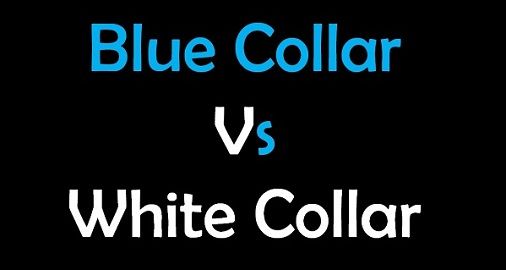 In an organization, there are hundreds of people working in the organization, which can be distinguished by the color of the dress worn by them. The color of the uniform specifies the job performed by the workers in the organization. Blue collar jobs are the jobs whereby the person performing the job does manual labor and gets an hourly or daily wage, based on the performance of their work.
In an organization, there are hundreds of people working in the organization, which can be distinguished by the color of the dress worn by them. The color of the uniform specifies the job performed by the workers in the organization. Blue collar jobs are the jobs whereby the person performing the job does manual labor and gets an hourly or daily wage, based on the performance of their work.
The second kind of jobs are the white collar jobs, wherein the employee does clerical work in an office and draws monthly salary at a fixed rate.
The difference between blue collar and white collar jobs is fading away with the passage of time due to the low pay scale of the white collar jobs and high demand of skilled labors. Here, in this article, the concept of the two types of jobs has been discussed, so take a read.
Content: Blue Collar Vs White Collar
Comparison Chart
| Basis for Comparison | Blue Collar | White Collar |
|---|---|---|
| Meaning | A job that requires physical labor is known as a Blue collar job. | A job that requires clerical work is known as a White collar job. |
| Color of Attire | Blue | White |
| Place of work | Field or industrial location like factory etc. | Office |
| Job performed by | Workers | Employees |
| Remuneration | Wages | Salary |
| Basis of Payment | Hours worked | Performance |
| Requirement of job | Muscle power | Brain |
| Payment cycle | Daily | Monthly |
Definition of Blue Collar
Blue Collar is a term used for the people of the working class, who performs manual labor for an organization and get paid wages on an hourly basis. The workers are supposed to wear a blue uniform during working hours. The job is highly laborious that requires physical strain, but the workers are not paid well.
The clothing of the workers is blue attire, the fact behind using such a color is that if a worker uses light colored clothes he will get soiled easily, and that will appear in his clothes. In blue color, the spots of oil & grease, dirt, and dust are not shown so easily, and that helps them to look cleaner.
Blue collar jobs do not require very higher education. However, a worker should be skilled enough in a specialized field to perform the work. The jobs may include manufacturing, mining, construction, repairs and maintenance, installation of machinery and so on.
Definition of White Collar
The term white collar refers to the jobs of officials, who performs managerial or professional work for the organization and get a fixed amount of salary as remuneration at the end of each month. The officials are supposed to wear white colored formal clothes, i.e. shirt, trousers, and tie. The employees do not have to perform any manual labor as well as their work is completely knowledge oriented.
White collar jobs require high educational qualification, mental sharpness, good knowledge and expertise in a particular area. As the officials work in offices, the place is clean and calm, so their dress code is white formals. The workers of white collar jobs are paid well and the basis of their pay is the performance.
The management jobs, engineering, medical and administration jobs are some examples of white collar jobs.
Key Differences Between Blue Collar and White Collar
The following are the major differences between blue collar and white collar:
- Blue collar jobs are a kind of job that needs a worker to perform physical labor in the workplace. White Collar jobs in which a person has to perform administrative or professional work.
- Blue collar workers wear blue attire so that dirt and dust are not shown. Conversely, White Collar workers wear white-colored outfits as their workplace is quite clean.
- The location of blue collar jobs is factories, industries, plant or site whereas in white collar jobs the employees work in offices.
- The persons who perform blue collar jobs are known as workers while the persons who perform white collar jobs are known as employees.
- The remuneration for blue collar jobs are waged while for the white collar jobs; salary is given as consideration for the work performed by the employees.
- Blue collar jobs require muscle power, but white collar jobs require a brain.
- The basis of payment for blue collar jobs is hours worked by the workers. In contrast to, white collar jobs, the payment will be based on their performance.
Conclusion
By comparing these two jobs, we came to the conclusion that blue collar jobs involve more laborious work in contrast to white-collar jobs. But still, the blue collar workers are paid less than white collar workers. The workplace for white collar jobs is clean and calm as compared to the blue collar jobs.






Anirudh says
satisfactory definition,
and a good comparision which helps the readers to understand much easily
SANDIP KHANAL says
It is clear definition and excellent comparison. Thank you.
Lara says
At last I understand much better. so I can explain better to my Deaf friends.
Sapna Sonar says
I found it more beneficial because it made very clear and conceptive.
JYOTHI H N says
I found it more beneficial information and clearly understand the topic conceptive
zidane says
thank you for the article